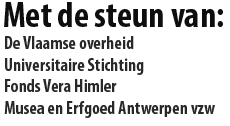E. ROBAERT
Zestiende-eeuwse bedevaarttekens en legpenningen in enkele Brusselse en Brabantse kerken: Jan Noë de vaantjesmaker van Halle
Summary: 16th century pilgrims tokens and medals in some Brussels and Brabant churches. Jan Noë, the flag producer from Hale (a town in Brabant).
Pilgrims’ tokens and medals were large-scale productions, sold by specialised stallholders and other 16th century salesmen. Jan Noë from Halle was, mid 16th century, an expert in this field, and one of the leading suppliers of small pilgrimage flags and medals to a great number of Brussels and Brabant churches. On the other hand, more expensive silver tokens, ordered in smaller quantities, were still the work of a silversmith. The church council, in the churches of which a patron saint as invoked in some typical popular devotions particularly ordered these tokens of devotion. In this study the historic evolution is outlined of the (church) medals and pilgrims’ tokens found in some churches, such as the St Peters church in Anderlecht (token of St Guido), the parish church in Machelen (token of St Gertrude), the parish church in Vorst (token of St Alena), and the St Leonard’s church in Zoutleeuw (token of St Leonard).
At that time Brussels was an important producing town of tokens of devotion, which in the town itself, as well as in other places of pilgrimage in the old duchy of Brabant, had a flourishing market.
,
R. NOUWEN
Hanengevechten in België: over de geschiedenis van het dagelijkse leven en de instandhouding van levend erfgoed
Summary: Cock-fighting in Belgium: about the history of daily life and the preservation of living patrimony.
Cock-fights have had a long tradition in Belgium. Few animals had such an immense impact on the recreational world of our ancestors, a phenomenon in known to historians of daily life and most readers as well.
Most publications deal with animals bred for fighting without mentioning any specifications. Furthermore the atrocious nature of cock-fighting is emphasized. The current concern for the well-being of animals, anyway fully appropriate, is an important reason why the breeding of fighting-cocks is put in a bad light.
But this leads up to the imminent extinction of three Belgian fighting-cock races.
The author wants to attract the readers’ attention to this problem. That is why he deals with the history of cock-fighting in Western Europe, more specifically in Flanders and the North of France and he dwells on the history of the fighting-fowl as well. He ends by remarking that fighting-cocks are an essential part of our cultural patrimony.
,
W.L. BRAEKMAN
Een Gentse bundel marktliedblaadjes
Summary: A Ghent collection of Flemish broadside ballads
This interesting made-up volume of broadsides was acquired by the Ghent Univ. Libr. In the late 19th century at the public sale of the collection of F.A. Snellaert. It Contains one hundred and thirty-nine items, for the better part unique. The broadsides also reveal the names of five market-singers whose existence is not known from other collections. This newly discovered quarto-sized volume illustrates the extent and scope of broadside ballads, mainly dated late 18th and early 19th centuries, which are still not even inventoried. It also goes to show that a full quasi-complete inventory of all existing broadside ballads (not to mention those reserved in manuscripts) is not a task the completion of which can be looked forward to in the near future.
This is why in the meantime all contributions towards this ultimate goal are welcome.
Each song of the collection analysed here is arranged alphabetically on its first line, the incipit, which is followed by the title, the melody, the length (number of stanzas and of verse) and the author and (or) singer, if available.
The article is completed by an alphabetical list of the melodies, and one of the singers.
,

